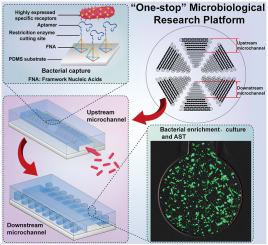Biosensors and Bioelectronics ( IF 10.7 ) Pub Date : 2020-12-29 , DOI: 10.1016/j.bios.2020.112943 Fulin Zhu , Xiaojun Bian , Hongcai Zhang , Yanli Wen , Qian Chen , Yongliang Yan , Liang Li , Gang Liu , Juan Yan

|
The limited reaction time and sample volume in the confined space of microfluidic devices give considerable importance to the development of more effective biosensing interfaces. Herein, the self-assembling of tetrahedral framework nucleic acids (FNAs) with controllable size on the interface of the microfluidic microchannels is studied. Compared with macroscopic turbulence control on traditional micro-structured microfluidic surface, the novel FNA-engineered microfluidic interface successfully constructs a 3D reaction space at nanoscale by raising DNA probes away from the surface. This FNA interface dramatically improves the reaction kinetics during molecular recognition due to extremely ordered orientation, configuration and density of DNA probes on the surface. Finally, the FNA-engineered interface is applied in a novel multi-functional microfluidic platform, towards a “one-stop” assay of Escherichia coli O157: H7 (E. coli O157: H7), integrating capture, release, enrichment, cell culture and antimicrobial susceptibility testing (AST). With the FNA-aptamer probe, we achieved an enhanced bacterial detecting efficiency (10 CFU/mL) plus excellent selectivity and precision. The appicability was strongly demonstrated when the biosensor was successfully applied in real samples, including the analysis of antibiotic susceptibility and minimum inhibitory concentration (MIC) of E. coli O157: H7 among different antibiotics. The application of FNA interface will open a wide avenue for the development of microfluidic biosensors for other pathogenic microorganisms or circulating tumor cells (CTC) simply by changing the aptamers.
中文翻译:

在集成微流控平台中基于四面体框架核酸的纳米生物适体界面的可控设计
在微流体装置的受限空间中有限的反应时间和样品体积对于开发更有效的生物传感界面非常重要。本文中,研究了在微流体微通道界面上尺寸可控的四面体框架核酸(FNA)的自组装。与传统的微结构微流体表面上的宏观湍流控制相比,新型FNA设计的微流体界面通过将DNA探针从表面移开,成功地在纳米级上构建了3D反应空间。由于表面上DNA探针的定向,构型和密度极为有序,该FNA界面极大地改善了分子识别过程中的反应动力学。最后,大肠杆菌O157:H7(E. coli O157:H7),整合了捕获,释放,富集,细胞培养和抗菌药敏测试(AST)。使用FNA-aptamer探针,我们可以提高细菌检测效率(10 CFU / mL),并具有出色的选择性和精密度。当将生物传感器成功应用于实际样品中时,包括在不同抗生素中对大肠杆菌O157:H7的抗生素敏感性和最低抑菌浓度(MIC)进行分析,就充分证明了该传感器的适用性。FNA接口的应用将为开发其他致病微生物或循环肿瘤细胞(CTC)的微流体生物传感器开辟广阔的途径,只需更换适体即可。











































 京公网安备 11010802027423号
京公网安备 11010802027423号